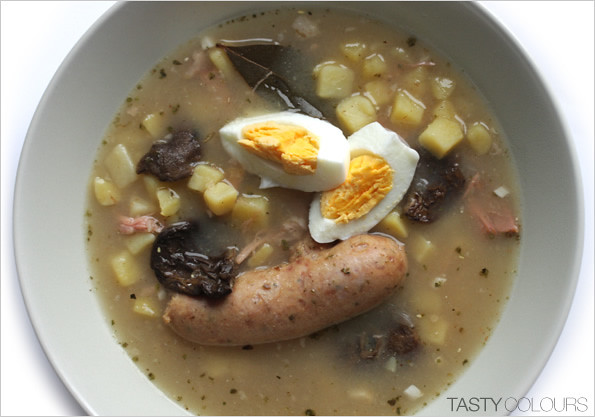You will find below a quick list of my few favorite “nightmare” dishes, which I could not stand when I was a kid:
- Scrambled eggs with veal’s brains (which I still hate)
- Milk soup (I still hate it now)
- Cooked spinach (I like now)
- And łazanki (which I now like).
Do you have any food nightmares from your childhood you want to share?
Łazanki. The “prototype” of this old pasta dish with square noodles was probably brought to Poland in the 16th century by Bona Sforza, the Italian wife of King Zygmunt Stary (the dish is known under the same name in Belarus as well).
As a child, I did not have any idea about the Italian origins of łazanki, but this was not the reason why I did not like it.
To me, the dish was synonymous of something overcooked, sticky, gluey, greasy, too salty or on the contrary not salty enough. I was a cantina kid and łazanki were usually served once a week in my school, prepared in the manner that I describe above. “Łazanki” were usually served with overcooked (or not cooked enough) sweet or sour white cabbage, pork back grease and pieces of sausage or ham. Sometimes some sour cream was added.
This is how I remember the dish. The only worse food was veal’s brain served with scrambled eggs, which I still hate nowadays.
Now I can eat łazanki, but it took me years. And, sorry guys! I only like the dish when I prepare it on my own – traumatic memories still work. I would rather cook the version without any bacon, although it is not so traditional.
There are my keys to my favorite and only łazanki dish I eat:
First of all, I use Savoy cabbage, instead of white cabbage. This preparation is quite well known, but is not so common. I do not like cooked white cabbage, although I like it raw or soured. On the other hand, I love cooked Savoy cabbage, which is more delicate and tender. I never use pork grease; instead, I use olive oil, butter or even goose grease.
Secondly, I make my own square noodles. They taste so much better in comparison to łazanki noodles you can buy in stores. Instead of all purpose flour, like in my recipe, you can try to use buckwheat flour, organic rye flour, but then you will have to be careful, as usually organic flour takes more liquid. This is why I give you the recipe for those simple square noodles.
Thirdly, I like to add bryndza and/or “oscypek-like” cheese to the dish, if I have them handy of course. If not, I add some fresh tomme, or gruyere, or nothing. Traditional łazanki usually is not served with any cheese.
Fourthly, I add a lot of fresh forest mushrooms. Surely you can use frozen ones, as you would do it now because the mushroom season is over.
Fifthly, I grill the whole dish in the oven before serving. Et voila!
You might remember that I wrote about oscypek a few weeks ago. Today I mention bryndza which is another cheese that may be used in the recipe. You probably do not know this cheese, and I owe you a few words of explanation.
Bryndza podhalańska is a Polish variety of the soft bryndza cheese, which is known in other countries of the region (for example, Slovakia). The name of the cheese probably finds its origins in the Romanian term “brinze”. The first written recipes for bryndza come from the XVIth century (confirmed in documents issued by landowners and in Royal decrees. Bryndza is made from sheep’s milk and it has a strong, salty or slightly salty taste, sometimes even sour. The cow’s milk content, if any is used, should not exceed 40 % of the total amount of milk used in production. Now it has a geographical indication under European Union law. Bryndza is produced only from May to September. You can buy industrial “substitutes” in markets or, from local farmers, all year round (usually both add more cow milk).
Bryndza usually is eaten as a topping on tartines, with addition of fresh, sliced tomatoes, sour cucumber and fresh herbs. It also is a wonderful filling for some types of pierogi, noodles, Polish-style gnocchis, button mushrooms and a variation of potato pancakes.
One last good thing about łazanki: it tastes even better the next day, after a night in the fridge.
Łazanki
Serves 4
Ingredients
400 g square noodles (recipe below)
500 g Savoy cabbage, washed and finely chopped
350 g fresh ceps or bolets
100 g bryndza and / or oscypek cheese (optional, you can use your favorite cheese or just omit it)
200 ml vegetable broth
2 onions, peeled, washed and finely chopped
4 tablespoons goose grease
2-3 tablespoons butter
2 bay leaves
2-3 grains allspice
Salt
Pepper
Preparation
Delicately clean the ceps from the leftovers of the forest.
Scratch the stems to remove soil.
Rinse the mushrooms delicately under cold water.
Dry them with a paper towel and cut them into parts of equal sizes. If the mushrooms are small you do not have to slice them.
In a hot saucepan, melt butter and cook onions until gold, for around 10 minutes, over a small flame. Do not let onions burn.
Add mushrooms and fry over a medium flame, mixing often, until the mushroom juice evaporates completely.
Simultaneously, in a second saucepan, melt the goose grease and cook the cabbage with bay leaves and allspice over a medium flame, until slightly soft.
Then add mushrooms and onions, pour the broth and cook slowly until the broth evaporates. Add cooked noodles. Salt and pepper generously and mix.
Place the dish in a backing pan, sprinkle with cheese and place into the oven preheat to 180 degrees.
Bake for 15 minutes, until the cheese is melted and slightly grilled.
Remove from the oven and serve hot.
Home made square noodles - łazanki
Serves 4
Ingredients
250 g flour
2 eggs
A pinch of salt
Eventually 2 tablespoons, water
Preparation
Sift flour on your working table.
Form a well in the centre.
Place eggs and salt in the well.
You can add 2 tablespoons of water at room temperature.
Mix all the ingredients with a plastic scraper and then knead the dough energetically.
After 10 minutes your dough should be elastic and ideally smooth.
Divide the dough into two equal parts.
Place one part on your working table.
Wrap the second half in a plastic film and put aside.
Sprinkle some flour on your station and start rolling out the dough until it is between 1 and 2 millimeters thick.
Occasionally, flip the dough and sprinkle some flour over it so it does not stick to the table.
When the dough is rolled out, let it dry out a bit for about 10 minutes.
After that time sprinkle a bit of flour over the dough and cut oblong strips of dough (about 1.5 cm wide). Then cut the strips across cut across to obtain squares of dough. Mix the noodles so they will not get sticky; they may even get a bit dry.
Repeat the actions with the second half of dough.
In a large saucepan, bring water to a boil and add some salt and a bit of oil.
Place the noodles into the boiling water by small batches at a time and cook between 6-8 minutes, depending on their thickness.
Strain the noodles. Rinse them under running cold water and use according to your recipe. You may also keep the noodles in the refrigerator for a few days before using them with your favorite recipe.
















